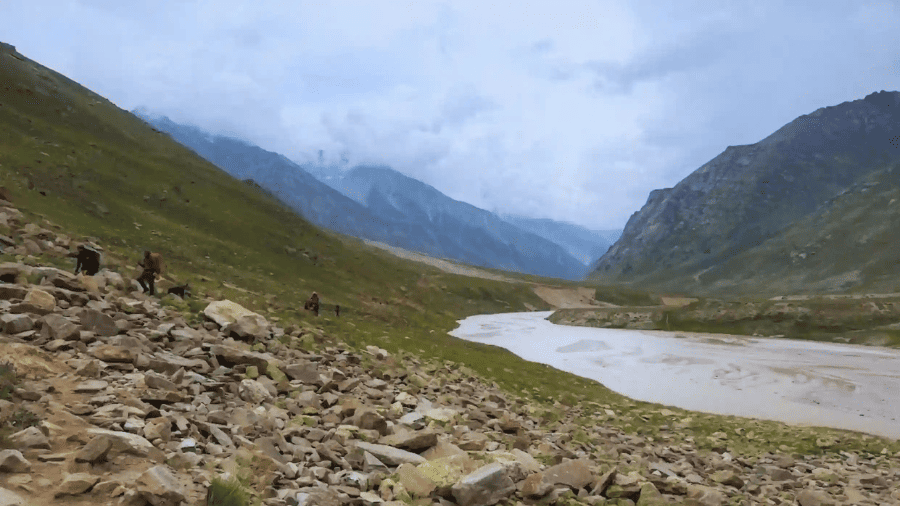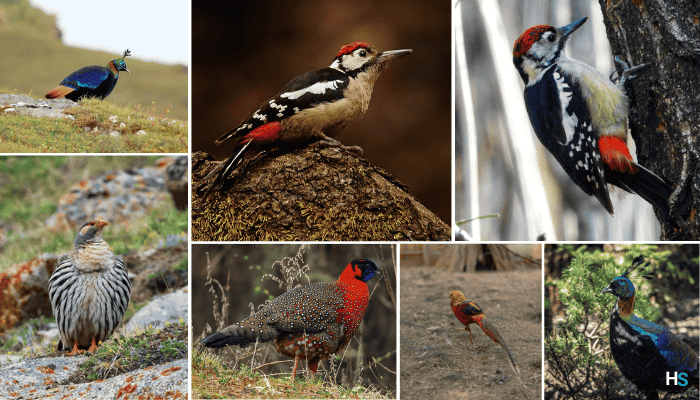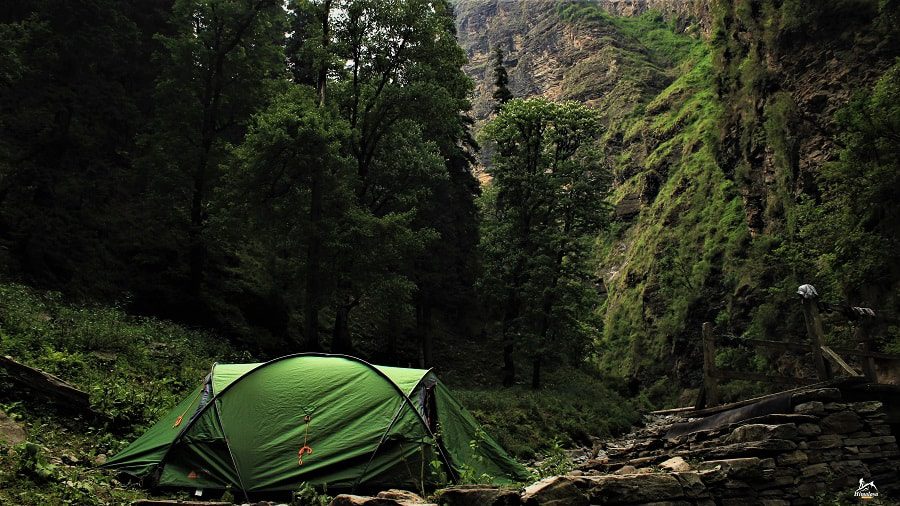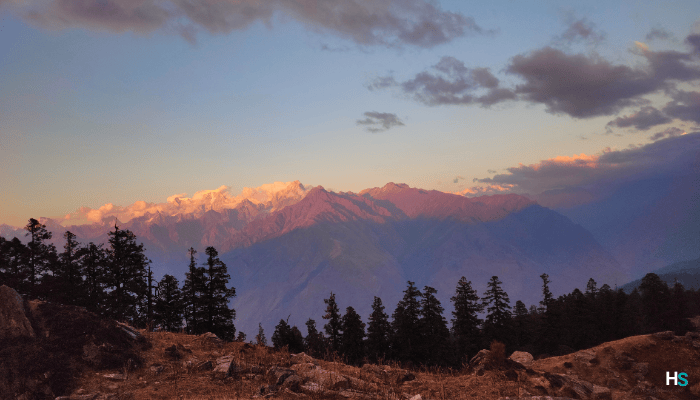
What Makes The Kashmir Great Lakes Trek In The Himalayas A Unique And Memorable Experience :
The Kashmir Great Lakes Trek is a unique and unforgettable experience, offering an opportunity to explore the pristine beauty of the Himalayas. The trek takes you through seven breathtaking alpine lakes that are a sight to behold. The trek offers a chance to witness the grandeur of glaciers and snow-capped peaks that surround these lakes.

The trek starts from the quaint village of Sonamarg in the state of Jammu and Kashmir and ends in the beautiful city of Srinagar. The trekking trail takes you through some of the most scenic landscapes that you will ever come across. The region is rich in natural beauty and offers a unique blend of stunning vistas, exotic wildlife, and ancient culture.

The first lake that trekkers come across is the Sheshnag Lake, which is a sparkling blue water body situated at an altitude of 3,658 meters. The lake is surrounded by lush green meadows and snow-capped peaks that add to its serene beauty. As you continue trekking, you will come across several other beautiful lakes, including Vishansar Lake, Gadsar Lake, Gangbal Lake, and Nundkol Lake. Each of these lakes is unique in its way and offers a spectacular view that is worth every bit of effort you put in during the trek.

Another unique feature of the Kashmir Great Lakes Trek is the opportunity to witness the grandeur of glaciers and snow-capped peaks. During the trek, you will come across several massive glaciers, including the Kolahoi Glacier, which is the largest glacier in the region. The trail also takes you through some of the highest mountains passes in the Himalayas, such as the Gadsar Pass and the Zaj Pass, both of which offer panoramic views of the surrounding peaks and glaciers.
Overall, the unique features of the Kashmir Great Lakes Trek make it an ideal destination for nature lovers and adventure seekers who are looking to explore the beauty of the Himalayas. The trek offers a unique blend of natural beauty, ancient culture, and adventure that is sure to leave you with memories that will last a lifetime.
How difficult is this trek?
The Kashmir Great Lakes is considered to be a moderately challenging trek, with a total distance of approximately 70-80 kilometres (43-50 miles) and an average trekking time of 7-9 days. The trek takes you through high-altitude alpine meadows, snow-covered mountain passes, and seven stunning glacial lakes.
The altitude of the trek varies from 7,500 ft to 13,750 ft, making it important for trekkers to acclimatize themselves before embarking on the trek. It is recommended to stay in Srinagar for a couple of days before the trek to help your body adjust to the high altitude.
The trek is doable for most people with a basic level of fitness and endurance, but it is important to prepare well in advance. Regular cardio and strength training exercises can help improve your fitness level and prepare you for the trek.
Trekking solo on the Kashmir Great Lakes Trek is not recommended, especially if you are inexperienced. It is always better to trek with a guide or a group of fellow trekkers who are familiar with the terrain and can provide support in case of emergencies. Additionally, trekking with a group can make the experience more enjoyable and provide a sense of camaraderie.
In terms of the best time to undertake the Kashmir Great Lakes Trek, the ideal months are from June to September. During this time, the weather is pleasant and the terrain is less challenging due to the lack of snow. However, it is important to note that the trek can still be physically demanding, even during the summer months.
Physical requirements for the Kashmir Great Lakes Trek
The Kashmir Great Lakes Trek is a high-altitude trek in the Himalayan region of Kashmir, India. The trek route covers a distance of approximately 70-80 kilometres, and trekkers have to navigate through varying terrain, including steep ascents and descents, rocky paths, and narrow ridges.
Fitness level and endurance are crucial for undertaking the Kashmir Great Lakes Trek, as the route involves high-altitude trekking, with an average altitude of over 4000 meters above sea level. The trek is considered moderate to difficult and is recommended for trekkers with prior high-altitude trekking experience.
Acclimatization is a crucial aspect of the trek, and trekkers are advised to take a day’s rest before starting the trek to adjust to the high altitude. Altitude sickness is a common problem among trekkers, and symptoms include headache, nausea, dizziness, and difficulty in breathing. To prevent altitude sickness, trekkers should stay hydrated, take it slow, and avoid alcohol and smoking.
Pre-trek preparation and training are essential for a successful Kashmir Great Lakes Trek. Trekkers should indulge in regular physical activities such as jogging, cycling, and hiking to build endurance and stamina. It is also recommended to practice breathing exercises to improve lung capacity and cardio fitness.
The best time to undertake the Kashmir Great Lakes Trek is from mid-June to mid-September when the weather is pleasant, and the trek route is accessible. However, it is advisable to avoid trekking during the monsoon season as the trail can get slippery and dangerous.
Solo trekking is not recommended for the Kashmir Great Lakes Trek, and it is advisable to trek with an experienced guide or in a group. The trek route is challenging, and the weather conditions can change rapidly, making it difficult for solo trekkers to navigate.
The Kashmir Great Lakes Trek is a popular trekking route, and trekkers can find many reviews and blogs online that provide detailed information about the trek. The trek route passes through seven magnificent lakes, each with its unique charm and beauty. Trekkers can also witness stunning views of the Himalayan mountain range and diverse flora and fauna along the way.
The cost of the Kashmir Great Lakes Trek varies depending on the trekking agency, the duration of the trek, and the facilities provided. The cost usually includes accommodation, food, transportation, and trekking equipment. Trekkers can get a detailed cost breakdown from the trekking agency they choose.
For navigation, trekkers can use a map of the Kashmir Great Lakes Trek, which provides an overview of the trek route and the seven lakes. The map can also help trekkers identify the major landmarks along the route.
Best time to trek the Kashmir Great Lakes
The best time to trek the Kashmir Great Lakes is from June to September, during the summer months. During this period, the weather is generally mild and the trek is less challenging. The temperature during the day ranges from 15-20°C, while at night it may drop to 7-10°C. This makes it an ideal time for trekkers who want to enjoy the beauty of the region without having to deal with harsh weather conditions.
During June and July, the region receives a lot of rainfall, and the trek can be more challenging due to the wet and slippery terrain. However, this is also the best time to witness the lush greenery and blooming wildflowers in the region. August and September are relatively drier months, with sunny and clear skies, making it a great time for photography and sightseeing.
The high tourist season for the Kashmir Great Lakes Trek is from July to August when the weather is ideal, and the trek is in full swing. During this time, the trekking routes can be crowded, and the accommodations may be more expensive due to high demand. The low tourist season is from June to September, except for the peak season months of July and August. During the low tourist season, the trekking routes may be less crowded, and the accommodations may be more affordable.
Choosing the best month to trek the Kashmir Great Lakes depends on personal preferences and fitness level. If you are an experienced trekker and want to challenge yourself, the monsoon months of June and July can provide a unique experience. However, if you prefer mild weather and clear skies, August and September may be the ideal months for you.
It is essential to be well-prepared for the Kashmir Great Lakes Trek, regardless of the time of year. The trek takes place at high altitudes, ranging from 11,000 to 13,800 feet above sea level. Trekkers should be in the good physical condition and well-acclimatized to the altitude before starting the trek. It is also recommended to take some rest days before starting the trek to help the body acclimatize to the high altitude.
Main attractions and scenic views:
The Kashmir Great Lakes Trek is one of the most popular trekking routes in the Himalayas and offers a unique experience to explore the region’s natural beauty. The trek is located at an altitude of around 13,750 feet above sea level and covers a distance of approximately 70 kilometres.
The seven lakes that make up the main attraction of the Kashmir Great Lakes Trek are Vishansar, Kishansar, Gadsar, Satsar, Nundkol, Gangbal, and Tarsar. Each lake has its unique features and beauty. Vishansar Lake is the largest and most prominent of the seven lakes, while Gangbal Lake is known for its crystal-clear water and serene atmosphere. Kishansar Lake is located at the base of a mountain, and its reflection in the water is breathtaking. The lakes are surrounded by lush green meadows, vibrant flowers, and a variety of wildlife.
One of the main highlights of the Kashmir Great Lakes Trek is the magnificent views of the Himalayan mountain range that trekkers can witness. The trail offers spectacular panoramic views of peaks like Kolhoi, Harmukh, and Gadsar. Trekkers also get a chance to walk alongside the Thajiwas glacier, which is a major source of the Lidder River.
The Kashmir Great Lakes Trek is also known for its diverse flora and fauna. The trek route passes through dense forests of pine, cedar, and fir trees, and offers a chance to witness rare Himalayan wildlife like the snow leopard, Himalayan brown bear, and musk deer. The region is also home to a variety of bird species like the Himalayan monal, golden eagle, and koklass pheasant.
Accommodations and facilities
The Kashmir Great Lakes Trek is a magnificent trekking route in the Himalayas that spans over a week and passes through some of the most beautiful landscapes in the world. One of the essential aspects of trekking is the accommodation and facilities available along the route. Here’s a detailed look at what to expect on the Kashmir Great Lakes Trek:
- Types of Accommodations Available:
During the Kashmir Great Lakes Trek, the primary accommodation option is camping. Trekkers typically spend their nights in tents at designated campsites along the trekking route. The campsites are usually set up in picturesque locations, and offer incredible views of the surrounding Himalayan mountains and the seven lakes of Kashmir.
- Facilities and Amenities Provided at Campsites:
The campsites along the trekking route provide basic facilities and amenities for trekkers. These include shared toilets and washrooms, kitchen tents, dining tents, and sleeping tents. The sleeping tents are equipped with comfortable sleeping bags and mats to ensure a good night’s rest. The kitchen tents are staffed by trained cooks who prepare hot and delicious meals using fresh ingredients. Breakfast, lunch, and dinner are usually provided at the campsites, along with tea and snacks. - Choosing the Right Camping Gear and Equipment:
As the Kashmir Great Lakes Trek involves camping, it’s essential to carry the right gear and equipment to ensure a comfortable and safe experience. Some essential gear and equipment that trekkers should carry include a sturdy backpack, trekking boots, warm clothing, waterproof jackets and pants, trekking poles, and a headlamp or torch. Other optional equipment may include a sleeping bag liner, a water bottle, a hydration pack, and a personal first aid kit.
Kashmir Great Lake Cost
The cost of the Kashmir Great Lakes Trek varies depending on the trekking company and the duration of the trek. The cost typically includes permits, accommodations, meals, and the services of trained guides and support staff. Trekkers should research different trekking companies and compare prices before booking.
Safety precautions for this trek
The Kashmir Great Lakes Trek is not only an incredible journey through breathtaking
landscapes, but it’s also an opportunity to experience the unique wildlife and flora of the region. As a responsible trekker, it’s important to be aware of the environment and take necessary safety precautions to ensure a safe and enjoyable trek. Here is some detailed information about the wildlife, safety precautions, and environmental conservation during the Kashmir Great Lakes Trek:
- Indigenous wildlife and flora of the region:
The Kashmir region is home to a diverse range of flora and fauna. Along the trek, you may encounter various species of birds, such as the Himalayan Monal, White-capped Redstart, and Himalayan Griffon. The area is also known for mammals such as the Kashmir Musk Deer, Himalayan Black Bear, and Snow Leopard. It’s important to remember that these are wild animals and should not be approached or disturbed. Additionally, the flora of the region is equally impressive with species such as the Himalayan Blue Poppy, Himalayan Primrose, and Himalayan Iris. It’s important to respect the environment and avoid damaging the natural habitat during the trek. - Safety precautions to keep in mind:
Trekking in the Himalayas can be physically demanding, and it’s important to take necessary precautions to ensure a safe trek. The Kashmir Great Lakes Trek is a high-altitude trek, and trekker must be prepared to face the challenges of trekking at high altitudes. Altitude sickness is a common concern among trekkers, and it’s important to acclimatize properly and seek medical attention if symptoms occur. Additionally, trekkers must carry appropriate gear and equipment, such as trekking poles, sturdy hiking boots, and warm clothing, to protect themselves from the elements. It’s also recommended to trek in groups and have a local guide or a trek leader for added safety. - Environmental conservation and waste management:
Responsible tourism and environmental conservation are critical during the Kashmir Great Lakes Trek. Trekkers are encouraged to follow the “Leave No Trace” principle, which means to leave the environment as you found it. This includes carrying all waste and litter, using designated campsites, and not damaging the environment. Additionally, it’s important to conserve water and use it wisely during the trek, as it’s a precious resource in the Himalayas. Trekkers must also be aware of the flora and fauna of the region and avoid damaging or disturbing them. As a responsible trekker, you can also contribute to the local environment by participating in local conservation efforts.
Local cuisine and must-try dishes
Kashmiri cuisine is known for its rich flavours and spices, and it is a must-try experience for food lovers on the Kashmir Great Lakes Trek. The cuisine has a strong influence from Central Asia and Persia and is heavily influenced by the availability of fresh ingredients in the region.
During the trek, trekkers can indulge in a range of local dishes at the campsite and in nearby villages. Some popular vegetarian dishes include Dum Aloo (potato curry cooked in a spicy tomato-based gravy), Rajma Chawal (kidney beans served with rice), and Chaman (paneer cooked in a spicy tomato-based gravy). Non-vegetarian options include Rogan Josh (a lamb dish cooked in a rich tomato-based gravy), Gushtaba (Kashmiri meatballs in a yogurt-based gravy), and Yakhni (a fragrant lamb broth).
In addition to these main dishes, trekkers can also try a variety of local snacks and desserts. Some popular snacks include Kashmiri Kulcha (a type of bread stuffed with paneer and served with chutney), Sheermal (a sweet bread flavoured with saffron), and Kebabs. For dessert, try the famous Kashmiri Phirni (a rice pudding flavoured with cardamom and saffron) or Shufta (a sweet made with nuts, raisins, and dried fruits).
It is important to note that while there are many delicious food options available during the Kashmir Great Lakes Trek, it is also important to be mindful of food safety and hygiene. Trekkers should make sure to eat only cooked food, avoid tap water, and wash their hands regularly to avoid any gastrointestinal issues. If you are planning to trek the Kashmir Great Lakes solo, it is important to keep in mind that food options may be limited at certain points along the trek. It is recommended to bring some snacks and portable food options to ensure you have enough to eat during the trek.
In terms of planning for the 2023 trek season, it is recommended to research local food options ahead of time and bring any necessary dietary supplements or medication, if needed. Additionally, it is recommended to inform your trekking guide or campsite manager of any dietary restrictions or allergies to ensure they can provide suitable food options.
Conclusion
In conclusion, the Great Kashmir Lakes Trek is a remarkable adventure that takes trekkers through some of the most stunning natural landscapes in the Himalayas. The trek provides an opportunity to witness the beauty of several high-altitude lakes, snow-capped peaks, lush green meadows, and quaint Himalayan villages. Along with the spectacular views, the trek also challenges trekkers with its difficult terrain and unpredictable weather conditions.
The Great Kashmir Lakes Trek is a must-do for anyone who loves adventure, nature, and trekking. The trek offers a unique opportunity to immerse oneself in the awe-inspiring natural beauty of the Kashmir Himalayas and to experience the rich local culture and hospitality. Overall, the trek is an unforgettable journey that will leave trekkers with memories that last a lifetime.
About Author

Himalaya Shelter
Recent news

23 Dec 2025

20 Dec 2025

18 Dec 2025

16 Dec 2025

10 Dec 2025
Recommended Treks

